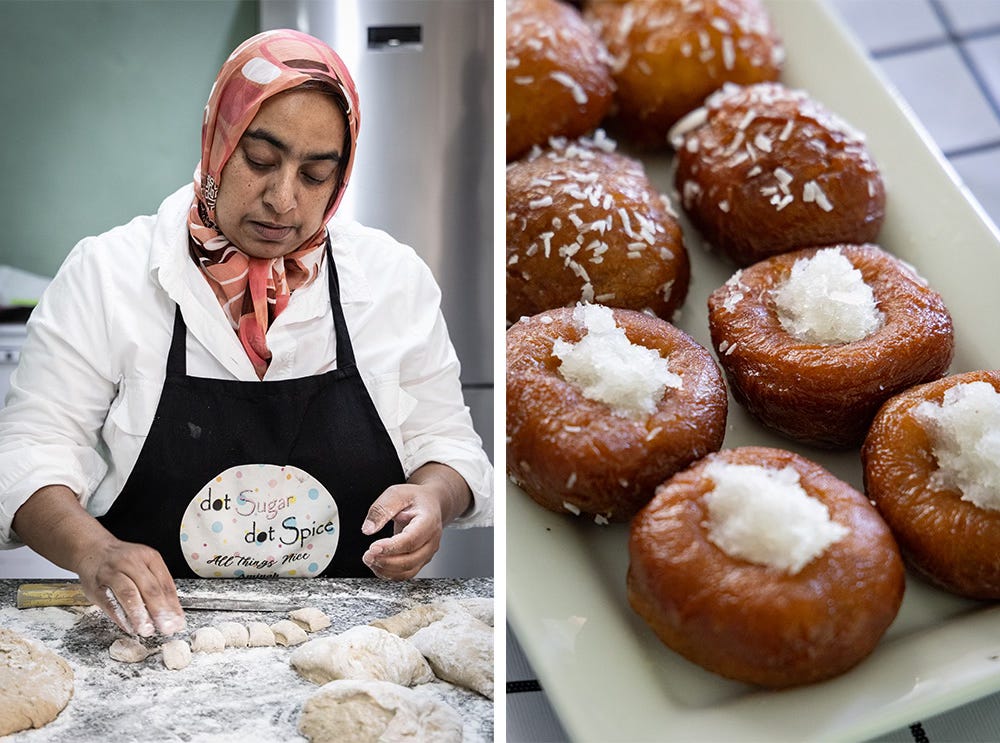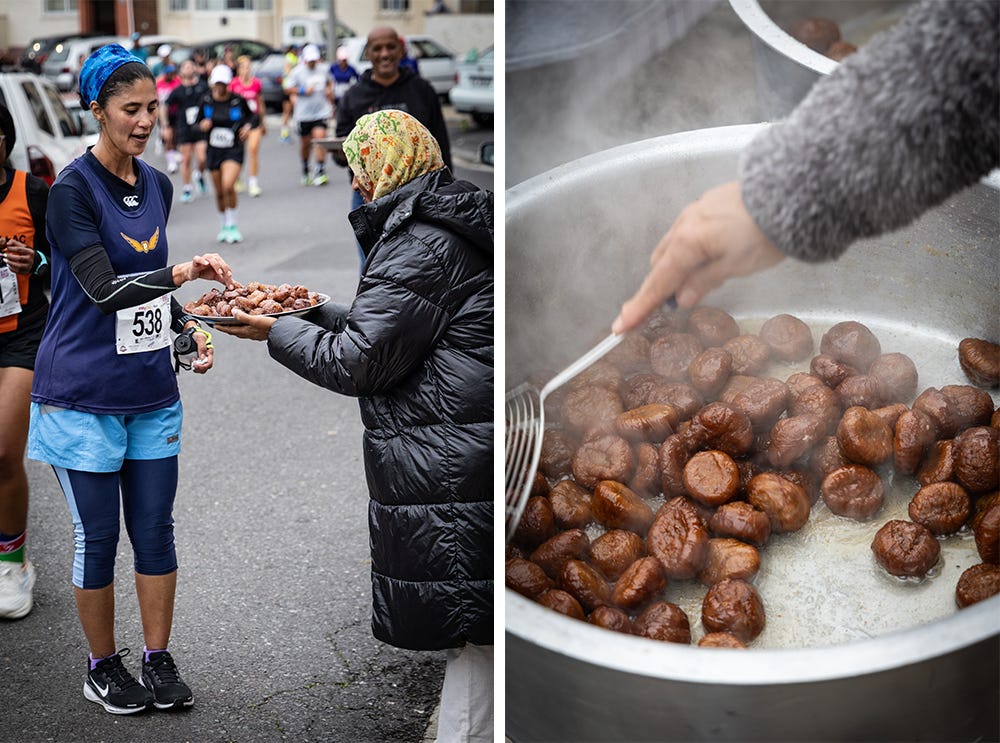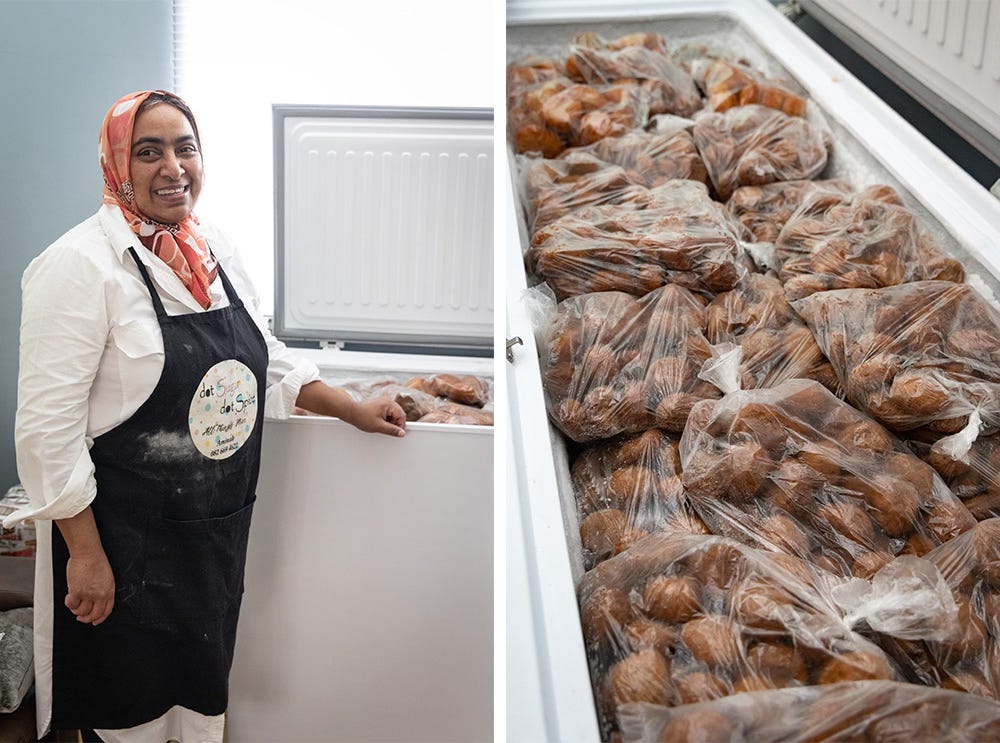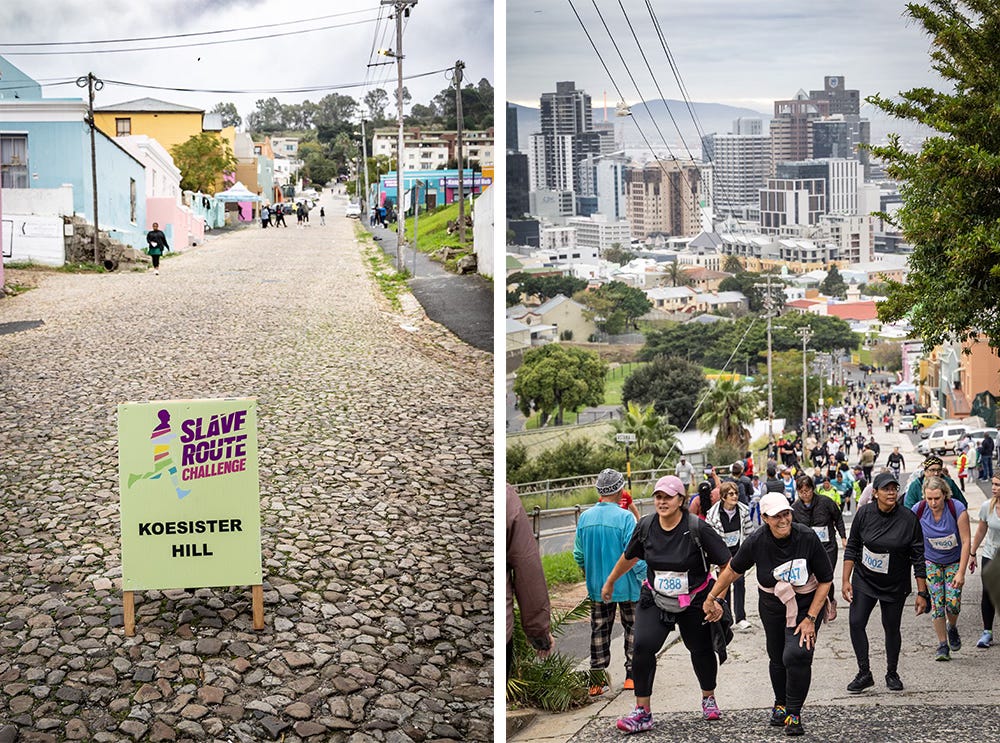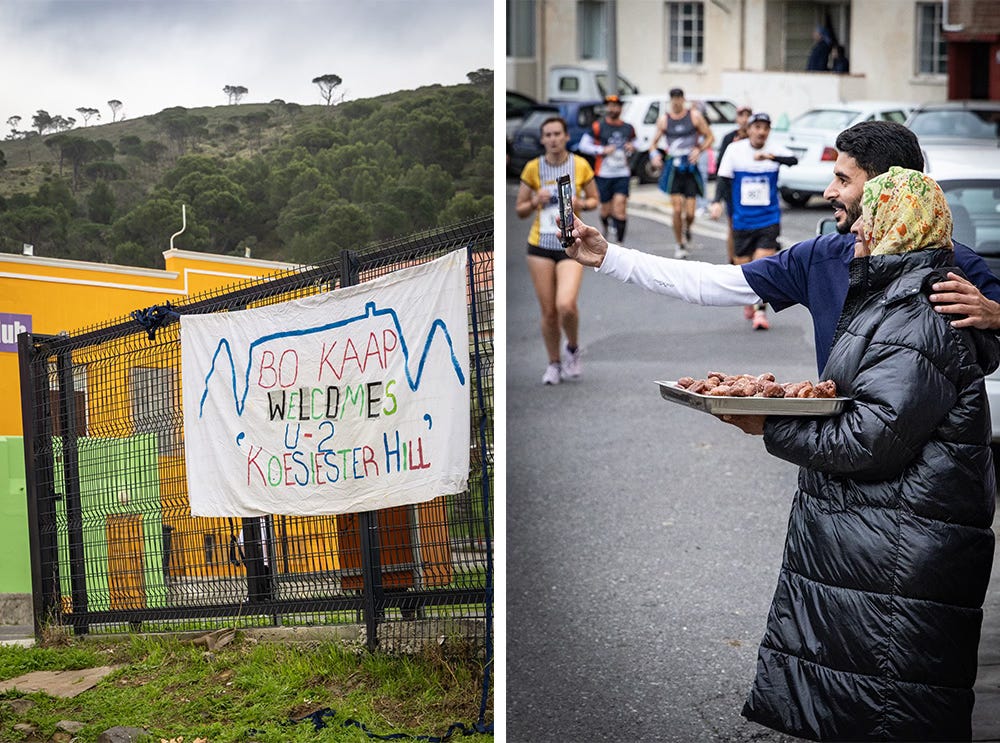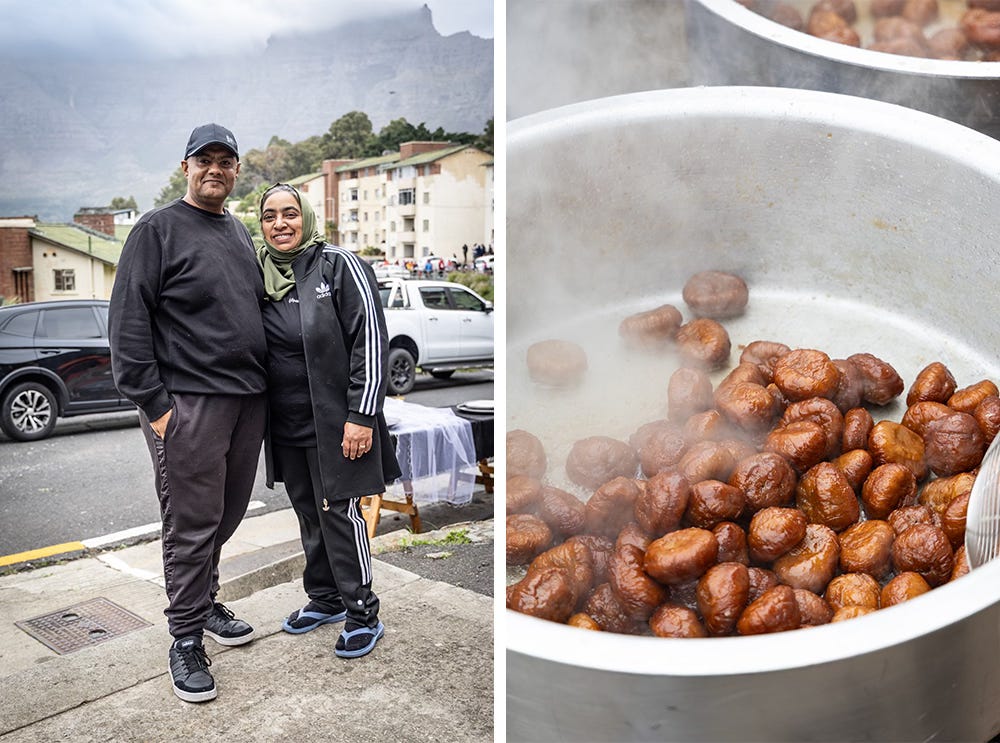‘Jackson – as in Michael,’ answers Aminah, glancing up with a smile, when I ask her maiden name. Aminah is mixing dough for koesiesters, the reward for the runners and walkers making it up ‘Koesiester Hill’ during Cape Town’s Slave Route Challenge. Sheer curiosity about who is responsible for the unseen work of making, rolling, frying, moved me to find out. Race organiser, Zarina Meyer-Brewer, explained there’s one woman tasked with producing the 10 000 koesiesters needed for the race and that is Aminah.
As we stand on Aminah’s doorstep in Kewtown, Athlone, the scent of sweet and spice wafts through the security gate to greet us. ‘It smells so good!’ I say to Jasmine Harris, who lets us in, ‘Every day,’ says Jasmine. When we gather in the kitchen a little later, Jasmine assists Aminah with the koesiester preparation. The koesiester is made of spiced, yeasted, sweet dough, shaped into elliptical rounds, fried, submerged in warm sugar syrup and rolled in coconut. Or with sweetened coconut tucked in the middle.
Pronounced koo-seester, whether it’s spelled koesister, koeksister, koe’sister or koesiester depends on the source1. Race participants who climb the steep, cobbled incline of Pentz Street in Bo-Kaap turn right at the top to be greeted with large, silver trays of koesiesters being offered on both sides of Voetboog Street. This Afrikaans road name translates directly as ‘foot arc’ or ‘foot bow’ and at the end of it is a mobile kitchen with multiple syruping pots – like the pot of gold at the end of the rainbow.
Farouk Meyer, who initiated the Slave Route Challenge, described the origins of this ritual, ‘[…] everybody said to me at the time, nobody is ever going to run up that hill. And today it’s the talking point of the race. The first year […] the community were so excited that there’s this event coming through that Bo-Kaap area. The community got together and made lots of koesiesters and coffee and tea for the runners […] and as the race grew, we included it in our budget. […] so, the runners get a nice warm koesiester when they get to the top.’
Almost 15 years since its inception, the 2025 Slave Route Challenge took place at the beginning of June. Zarina and Aminah explain that Spice Mecca sponsored the koesiester mix, which provides the dry ingredients pre-weighed and informs the spice flavour profile. The packet lists mix spice, whole aniseed, fine ginger, and fine cinnamon, along with wheat flour, sugar, and salt.
When we visit, Aminah sets out three different koesiesters to taste. There are two variations on the coconut-coated kind – one is spiced and the other plain or unspiced. The third resembles a deeply golden, glistening ring doughnut but with a centre for cradling a spoonful of coconut. It’s the first one we try.
‘That was how my mom did it back in the day,’ says Aminah, as we take a bite. The inside is juicy with syrup and duskied by spice, which Aminah expands on, ‘The cinnamon gives taste, but it also changes the colour.’ Mid chew, brushing sticky coconut from my lips, I find my myself exclaiming: ‘It’s so light!’
That lightness is what Aminah prizes, and she attributes it to learning the making from her mother, Labiba Jackson. ‘My mom was the queen; she used to do the koesiesters. Everybody bought from her. Everybody,’ says Aminah as we drink coffee together in the front room where, she later explains, she receives customers collecting orders for her koesiesters and savouries.
It’s clear, as we watch Aminah work against the sage green backdrop of her kitchen, that the technique is in her touch. On observing she’s working by feel, Aminah replies, ‘Yes, and it works perfectly every time. And obviously by hand. I could use my mixer, but you know what the mixer does? It makes it a bakery-style koesiester. And when I say bakery style, it makes it more dense […] so we prefer to just mix with our hands.’
The risen dough is tipped onto the floured counter. It looks light and extendable with a loose stretch but just enough hold and Aminah handles it with a natural ease that speaks, not only of 10 000 koesiesters, but of 10 000 hours. Aminah explains that she does the rolling and cutting herself, to ensure a uniform size and shape. ‘It’s bite size,’ she says, cutting off gnocchi-sized sections and rounding each one off with two quick folds. Once the trays are filled, Jasmine starts heating oil in a pan for the frying.
Syruping the koesiesters is a team effort and takes place in situ at the top of Bo-Kaap. Aminah describes her MO: stoves and pots are transported the night before and she leaves home around 3am on the day. She shares how she’s streamlined the process, investing in a double chest freezer of serious proportions and a substantial car port so she can load up her gas burners without fear of being caught in the rain between the kitchen door and her van. Before we leave, she lifts the lid on her freezer to reveal all the many knotted bags of koesiesters, ready and waiting.
The Slave Route Challenge highlights the unseen by raising awareness around history and heritage. It acknowledges that ‘Cape Town was built by those who were enslaved and apprentices from Indonesia and Malaysia, and many Capetonians trace their ancestry through these resilient communities’2. The route runs through parts of the city that tell this story, and the Bo-Kaap is a landmark area in terms of emancipation and pre-apartheid diversity. It also has a unique aspect and as Farouk puts it, ‘The best view of Cape Town.’
Race day
Aminah’s race-day kitchen looks onto Table Mountain, with the cable station just visible at the edge of some moody, low-hanging cloud. When we arrive at around 8am, spectators are gathered on the balconies of adjacent flats. Below them, four women (including Jasmine) syrup and scoop koesiesters from steaming pots, tumbling them in coconut before distributing trays down the length of road. Aminah’s husband, Zaheer Khan, is there, pitching in as needed, and her father-in-law, Osman Khan, is documenting the day with video and photographs.
As Aminah predicts, the first batch of runners don’t stop – they’re chasing specific times. But with the next few waves, interest peaks quick and fast. Those who didn’t know to expect doughnuts en route express gratitude and delight. One or two who do, are bold enough to pull packets from their rucksacks ready to load up with takeaways. Some stop to take selfies with the team and at one point there’s a steady refrain from passing runners: ‘Thank you! Thank you! Thank you!’
‘This is what love looks like!’ shouts one runner. Zaheer turns to me and says, as if in reply, ‘This is what Sunday in the Bo-Kaap looks like.’ He’s referring to enjoying koesiesters on a Sunday morning, whether made at home or collected from one of the women who make for the community in their kitchens3. Zaheer continues, ‘When we first met, Aminah gave me a bolla she’d made and I went all emotional, because it took me right back to my granny. This is heritage. It’s tradition.’
The koesiester is far more than a conveniently sized source of energy. To Zaheer’s point, what makes it particularly special is that it’s imbued with the heritage of the place where its offered. And with men and women showing up to help with syruping and handing out on race day, there’s a spirit of community.
‘By 12 [noon] we’re packed up,’ says Aminah, ‘Whatever we can, we wash up there, I take everything with, so everybody helps, instead of me bringing everything back here. And they actually enjoy it! Because I take 40 to 50 pies with, some of my own syruped koesiesters, and we have coffee. And if I have time, I make sandwiches, just for them to have.’
To be honest, the koesiesters were a major motivating factor in signing up to run the Slave Route half marathon two years ago and I’m sure I’m not alone. ‘There are easier ways to enjoy a koesiester, you know,’ teased a fellow runner, ‘you could just buy one.’ True, but that wouldn’t involve running through District Six, past the Slave Lodge and the Slave Tree plaque, getting a first-hand feel for the rise and fall of Bo-Kaap streets and reflecting on Cape Town’s sobering history. As in taste so in life, understanding bitter provides the context for a full appreciation of sweet.
If you live in Cape Town and would like to order koesiesters from Aminah call or WhatsApp her on 082 669 4622.
Those participating in the 21.1km, 10km run and 10km walk head up Koesiester Hill. This year, to make sure everyone got a koesiester, Aminah made extra for those finishing the 5km event on the Grand Parade. For more information about the Slave Route Challenge, click here.
The spelling used in this piece is on the advice of Farouk Meyer.
https://www.slaveroute.co.za/event-overview/
Bo-Kaap Kitchen: heritage recipes and true stories photography by Craig Fraser, text by Maggie Mouton, guide Shireen Narkedien (Cape Town: Quivertree Publications, 2013)






